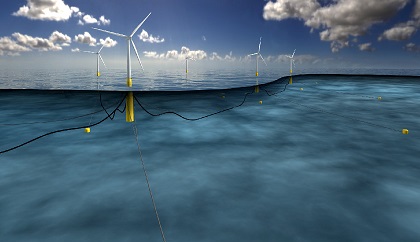
The new technology will allow developers to build further offshore and in deeper water.
The world's largest floating offshore wind development will be installed off the coast of Peterhead after the application has been granted a marine licence by the Scottish Government.
Statoil propose developing a pilot park of five floating 6 MW (mega watt) turbines which is to be located approximately 25km off the coast of Peterhead. It will have a generating capacity of 135GWh of electricity each year.
Based on those numbers, it is expected that the Hywind Scotland development could power up to 19,900 houses.
Maggie McGinlay is the Director of Energy and Clean Technologies at Scottish Enterprise, she says they are encouraged by the opportunity this project presents:
Unlike conventional turbines, Hywind turbines will be attached to the seabed by a three-point mooring spread and anchoring system.
The turbines will be connected by an inter-array of cables and an export cable will transport electricity from the pilot park to shore at Peterhead.
The newer technology allows developers to go look at sites further out to sea in deeper waters.
The Carbon Trust believe that floating wind concepts have the potential to reduce generating costs to below £100/MWh in commercial deployments, with the leading concepts such as Hywind, with even lower costs of £85-£95MWh.
Welcoming Statoil's Hywind development after granting consent, Deputy First Minister John Swinney said:
''Hywind is a hugely exciting project – in terms of electricity generation and technology innovation – and it's a real testament to our energy sector expertise and skilled workforce that Statoil chose Scotland for the world's largest floating wind farm.
''The momentum is building around the potential for floating offshore wind technology to unlock deeper water sites. The ability to leverage existing infrastructure and supply chain capabilities from the offshore oil and gas industry create the ideal conditions to position Scotland as a world leader in floating wind technology.''
Statoil's executive vice president for New Energy Solutions Irene Rummelhoff said:
''Floating wind represents a new, significant and increasingly competitive renewable energy source. Statoil's objective with developing this pilot park is to demonstrate a commercial, utility-scale floating wind solution, to further increase the global market potential. We are proud to develop this unique project in Scotland, in a region that has optimal wind conditions, a strong supply chain within oil and gas and supportive public policies."


 Public consultation on Cupar North development opens
Public consultation on Cupar North development opens
 Man, 44, seriously injured in hospital after crash between Comrie and Rosyth
Man, 44, seriously injured in hospital after crash between Comrie and Rosyth
 John Swinney announces SNP leadership bid
John Swinney announces SNP leadership bid
 11°C
11°C
 17°C
17°C